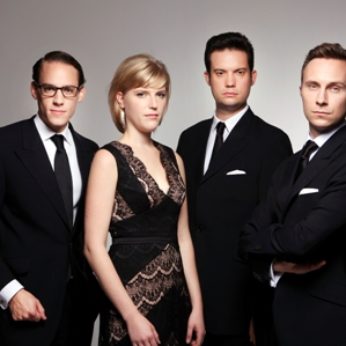Composer: Ludwig van Beethoven (b. 1770 - d. 1827)
Performance date: 02/07/2014
Venue: Bantry Library
Composition Year: 1824-5
Duration: 00:40:24
Recording Engineer: Richard McCullough, RTE
Instrumentation: 2vn, va, vc
Instrumentation Category:String Quartet
Artists:
Doric String Quartet (Alex Redington, Jonathan Stone [violins], Hélène Clément [viola], John Myerscough [cello]) -
[quartet]

Beethoven’s last quartets were the result of
a commission from Prince Nicholas Galitzin, an accomplished musician, who wrote
to him from St Petersburg in November 1822 asking him if he would be willing to
compose one, two or three new quartets
for which labour I shall be glad to pay you what you think proper. The E
flat Quartet is the first of the three works that resulted from this
commission, being completed in 1825 and first performed by the Schuppanzigh
Quartet on 6 March that year.
The famous maestoso chords that open this quartet warn us immediately of the
immense power and solemnity of this extraordinary work. These massive chords
keep returning during the movement and each time you feel Beethoven is trying
to break down the doors of perception for us – until we reach the coda, when it
is no longer necessary, for the gateway to the Adagio is now open. The strange
thing is that despite the intellectual and emotional ferocity of much of this
movement, there is another part that just dances, dances for joy. The mighty
opening reappears twice in the movement, at the very end of the exposition and
in the middle of the development. The exposition is very short with an
undulating and lyrical first subject followed by a softer spoken and
structurally less important second subject. This leads through a
tension-building tailpiece back to the maestoso
introduction and then the development. This seems restrained in contrast to
the massive maestoso chords, which
return once more unannounced. At the end of the recapitulation we are led into
expecting their final reappearance but instead after a dramatic pause, the
intensely lyrical coda takes its place.
Adagio
but not too much so and very songful is
Beethoven’s instruction for this quartet’s sublime slow movement. The form is
simple, a set of six variations on a rapt and expressive melody, but what is
heart-stopping is the way Beethoven uses changes in rhythm and tempo to
dislocate our sense of time so that by the third variation we find ourselves in
a new world, where time no longer exists. The sense of other-worldliness is
palpable and when the sixth variation stops mid-phrase and we are left in
silence, it is as though for a fleeting moment that we can hear the music of
the spheres that so obsessed the ancients. After this time-stopping pause, the
coda starts up with the simple beat of the cello’s accompaniment before the
violin gravely dances out with the theme one more time.
The angular accents and gritty realism of
the Scherzo bring us back to earth with a jolt. This is regularly interrupted
by dramatic pauses and questions as if asking where to go next. Some amusing
question and answer sessions are also built into the structure. The Trio is
reached by a series of stops and starts, but once started it sets off at
headlong speed in E-flat-minor, its second subject using a drone bass to add
weight to its argument. The Scherzo slips back in by the back door so to speak
but quickly generates its momentum again. The coda is another trickster,
kidding us into expecting a repeat of the Trio and then abruptly halting,
stranding us in mid-air.
The sonata form Finale opens with a four bar
unison introduction that, as in the first movement, is recalled before the
development. The main theme with its attractive rocking accompaniment is first
heard on the first violin. The second subject is march-like and leads to a
striking passage featuring powerful discords. The development is very short and
concise, concerning itself with both subjects and even combining them at one
moment. The recapitulation is a simple parade but the coda is another treat in
keeping with the rest of the work. As the discord passage sinks down, a soft
swirling cloud of trills sweeps over the music as the main theme is expanded
into an ethereally lyrical conclusion.
Copyright © 2025 West Cork Music. All rights reserved.
Designed and developed by Matrix Internet